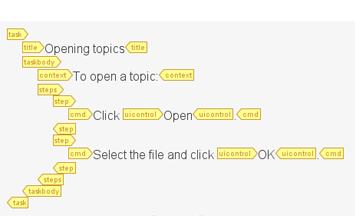

But I didn't want to figure out how to do that at this point. Now, the proper thing to do would be to configure DITA to point at the real location of the theme's CSS, I guess. I copied my APEX theme's CSS file to that same place and renamed it commonltr.css (in my case that was APPSERVER_HOME/apache/apache/images/themes/theme_13/theme_V3.css). * The DITA toolkit generates html pages that look for a CSS called commonltr.css, located at the same level as the index.html file. In my case this was APPSERVER_HOME/apache/apache/images/doc/MyAppHelp/ * I run APEX using Oracle Application Server 10g, so I uploaded the files to a subdirectory of their own in the i/ folder on the OAS server. I made a concept topic for each page of my application with the filename "Concept_About_page_X.dita," where X is the APEX page number. I did this so that I wouldn't have to worry about linking to a different folder from APEX (more on that later). I set up my files so that they would all be in a topics subfolder, rather than the standard task, concept, and reference folders of the example. * Created an html user guide by modifying the garage sample that's included with the DITA open toolkit and publishing to xhtml (I also published to pdf2, by the way, to provide a printable user guide for my users to download.one of the nice things about DITA). I'm not endorsing this thing, but it's free and it works great out of the box for editing DITA files. * Downloaded and installed XMLmind XML editor free personal edition version ().
#Free xmlmind dita editor full#
* Downloaded the DITA open toolkit ( ), full package distribution and installed using the user guide ( )

I then used iframes in the APEX help page to allow me to have a TOC always showing with links that controlled a content "pane," but still also display the automatically-generated item help for the page help is called from. I'm no html genius, so this may be totally wrong, but what I did was to create a task oriented html user guide that also included a page based help TOC entry for each page. But, I also like the context-based feel of a page-based help system and the way that the APEX help system automatically aggregates all of the item-based help on a page for you. I like the DITA (Darwin Information Typing Architecture) system's topic based help with its ideas of tasks, concepts and references. I prefer to use a task-oriented help system for that, with a table of contents that users can browse around in. The APEX page-oriented help system is bad at helping users find how to do something. 1.7K Training / Learning / Certification.165.3K Java EE (Java Enterprise Edition).7.9K Oracle Database Express Edition (XE).3.8K Java and JavaScript in the Database.


 0 kommentar(er)
0 kommentar(er)
